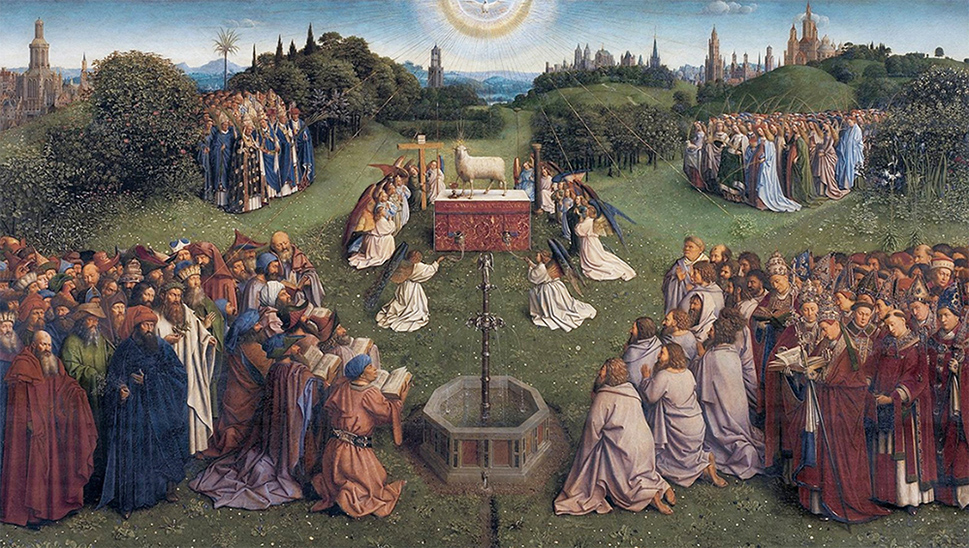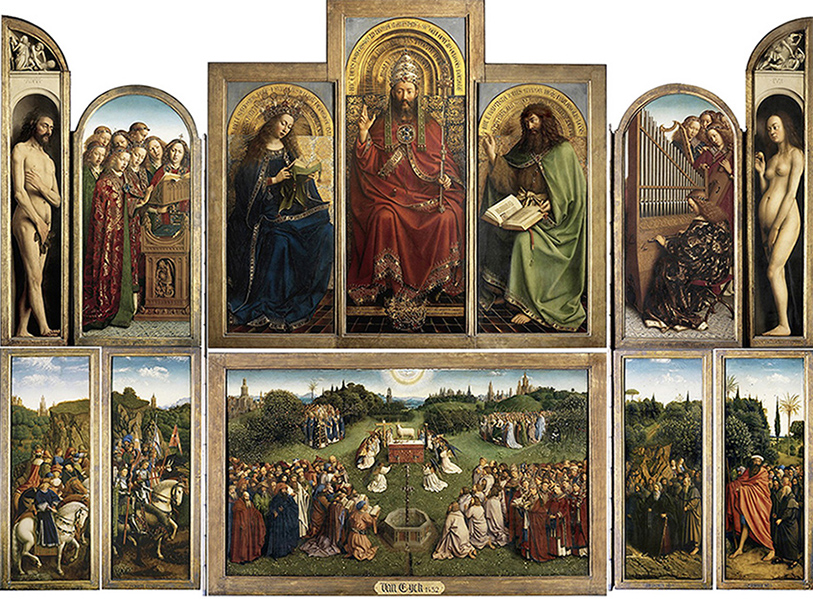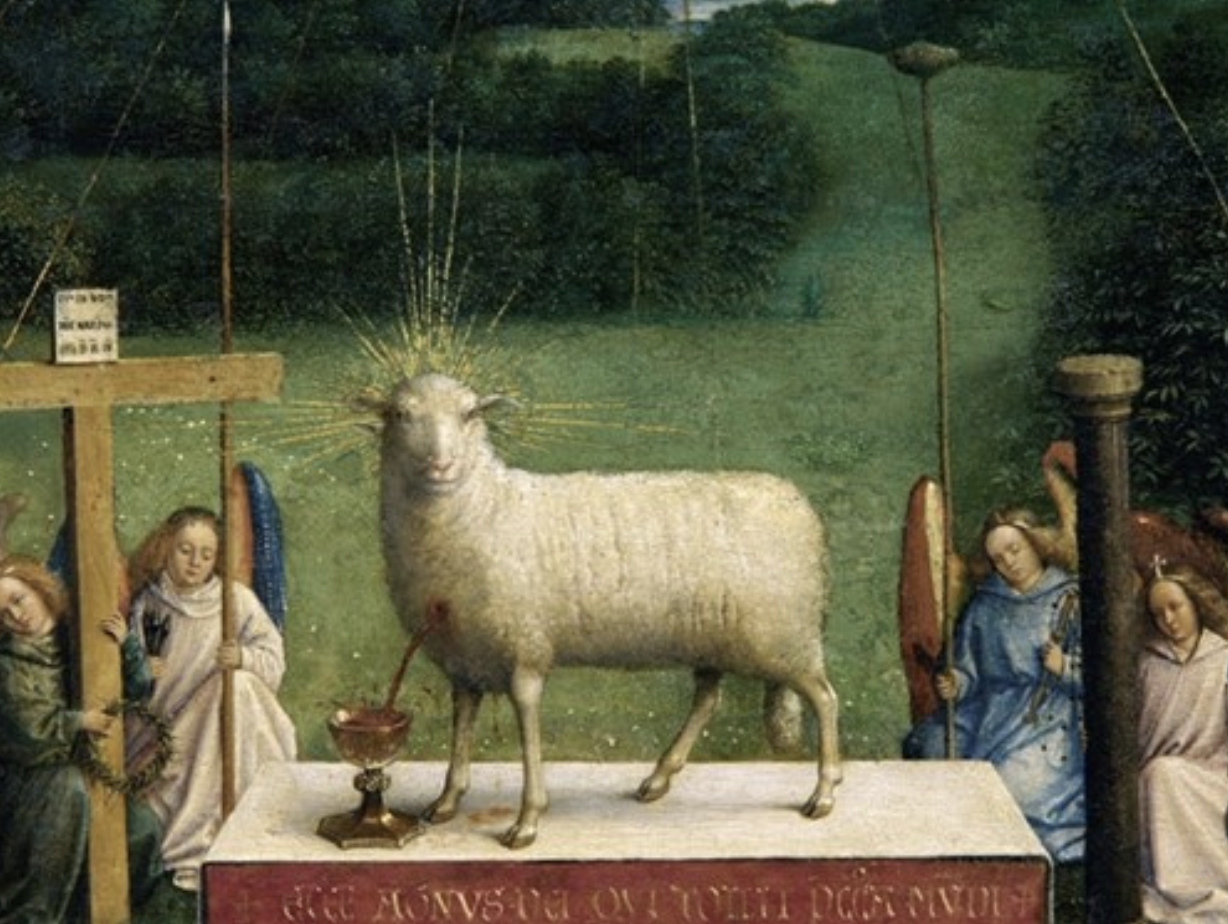January 5: The Marriage Supper of the Lamb
♫ Music:
Day 36 - Sunday, January 05
Title: The Marriage Supper of the Lamb
Scripture #1: Song of Songs 2:4 (NKJV)
He brought me to the banqueting house, and his banner over me was love.
Scripture #2: Revelation 19:6-9 (NKJV)
And I heard, as it were, the voice of a great multitude, as the sound of many waters and as the sound of mighty thunderings, saying, “Alleluia! For the Lord God Omnipotent reigns! Let us be glad and rejoice and give Him glory, for the marriage of the Lamb has come, and His wife has made herself ready.” And to her it was granted to be arrayed in fine linen, clean and bright, for the fine linen is the righteous acts of the saints. Then he said to me, “Write: ‘Blessed are those who are called to the marriage supper of the Lamb!’ ”
Poetry:
“The Lamb
by Linda Gregg
It was a picture I had after the war.
A bombed English church. I was too young
to know the word English or war,
but I knew the picture.
The ruined city still seemed noble.
The cathedral with its roof blown off
was not less godly. The church was the same
plus rain and sky. Birds flew in and out
of the holes God’s fist made in the walls.
All our desire for love or children
is treated like rags by the enemy.
I knew so much and sang anyway.
Like a bird who will sing until
it is brought down. When they take
away the trees, the child picks up a stick
and says, this is a tree, this the house
and the family. As we might. Through a door
of what had been a house, into the field
of rubble, walks a single lamb, tilting
its head, curious, unafraid, hungry.
THE MARRIAGE SUPPER OF THE LAMB
The final chapters of the book of Revelation follow more drama than most readers can comprehend. We read about angels and hideous monsters and violence. A pregnant woman is threatened by a vicious red dragon who seeks to devour her child. Both child and mother escape, but the dragon rages and unleashes more monsters on the earth. The book overflows with imagery, admonitions, and encouragements that have resonated with people throughout the ages.
Just before God does the final mopping up of the earth—ridding it of evil, sin, and death—people shout praises as the invitations are sent out to the faithful of God because the Marriage Supper of the Lamb is soon to take place. It’s as if the people have connected the historic dots and are now confident in God’s ultimate, redemptive work in the world. We come to understand that this Lamb is also the child that was born to the woman and who lived under the shadow of suffering and death, ending up as the slaughtered Lamb of Revelation. The child is vulnerable in his birth and the Lamb is weak in its death, and yet the child/Lamb conquers all of the powers of evil. And the people receive their invitations to the marriage supper with the kind of joy that is reflected in the praise found in the Song of Songs, a joy that is as intimate as it is jubilant:
He brought me to the banqueting house, and his banner over me was love. (Song of Solomon 2:4)
Jesus talked about this, but in a much less dramatic way than is depicted in Revelation. He said, “I will come again and receive you to Myself; that where I am, there you may be also . . .” (John 14:3)
Jesus came to people in real time, in real life, with all the grit and suffering and wonder that is earthly existence. When he returned to receive his followers, he received them in that same real life. Like all human beings, the lives of the faithful have been plagued by suffering and death, but we’re told in Revelation that Jesus returns to usher in the new heaven and the new earth.
It’s an odd sort of connection, this relationship between heaven and earth. Jan van Eyck’s Ghent Altarpiece captures this relationship as he offers Biblical depictions, some highly stylized, along with actual buildings and landscapes of his own time, as well as references to contemporary figures. The blending of images is a reminder that the biblical narrative is always lived out in daily human existence.
The image of the faithful being invited to the Marriage Supper of the Lamb even before God’s work of justice is complete provides something very important for us. Like the first people who heard the words about John’s vision in Revelation, we live in a world that is violent and broken. And yet, it is God’s good creation beneath it all, and when God reconciles all things to himself, there will be a new heaven and new earth. We don’t see that reconciliation at this moment, but we remain confident in what God will one day bring to fulfillment, because God has already made his intentions known through the first coming of Jesus in his birth, suffering, death, and resurrection.
And in that confidence, we give glory to God.
Prayer:
God our Father,
Grant in us, O Lord, to trust in you with all our hearts, and in that trust to give you glory. You never forsake those who make their boast of your mercy, and our confidence is in you. Through Jesus Christ our Lord, who lives and reigns with you and the Holy Spirit, one God, now and forever.
Amen.
Michael McNichols, D.Min.
Pastor and Author
For more information about the artwork, music, and poetry selected for this day, we have provided resources under the “About” tab located next to the “Devotional” tab.
About the Artwork:
Ghent Altarpiece—Adoration of the Mystic Lamb (overall and detail views)
Hubert van Eyck and Jan van Eyck
1420s–1432
Twelve-panel altarpiece
St. Bavo's Cathedral
Ghent, Belgium
Public Domain
One of the greatest masterpieces ever painted, the Ghent Altarpiece, was created in the 15th century by Flemish brothers Hubert and Jan Van Eyck. The key panel of the altarpiece, the Adoration of the Lamb depicts a large meadow at the center of which are two structures––a rectangular stone fountain and an altar with the Lamb of God standing atop. The surrounding angels hold instruments of the Christ’s Passion––a column on which Christ was tied during the flagellation; the vinegar sponge that quenched his thirst as he was on the cross; the nails and lance that pierced his flesh. The Lamb bleeds from a wound in his side, and this stream of blood flows directly into a chalice on an altar cloth that reads: "Ecce Agnus Dei, qui tollis peccata mundi, miserere nobis" which translates to "Here is the Lamb of God, who takes away the sins of the world.” The fountain is a symbolic reference to the promise of eternal life made possible by Christ's sacrifice. Inscribed on the fountain, in Latin we see a verse from Revelation––"Then the angel showed me the river of the water of life, clear as crystal, proceeding from the throne of God and of the Lamb." (Revelation 22:1). Across the panels at the bottom are groups of gloriously arrayed figures—righteous judges, apostles, angels, prophets, patriarchs, female saints, confessors, martyrs, holy hermits, and pilgrims—all of whom have gathered to worship the Lamb of God. All the scenes in the Ghent Altarpiece invite the viewer to share in the promise of Christ’s glorious salvation.
https://smarthistory.org/van-eyck-the-ghent-altarpiece/https://en.wikipedia.org/wiki/Ghent_Altarpiece
https://www.britannica.com/topic/Ghent-Altarpiece
About the Artists: Hubert van Eyck and Jan van Eyck
Hubert van Eyck (c. 1385/90–1426) was an Early Netherlandish painter and older brother of Jan van Eyck. The absence of any single work that he can clearly be said to have completed continues to make an assessment of his achievement highly uncertain, although for centuries he had the reputation of being an outstanding founding artist of Early Netherlandish painting. The division of surviving works between Hubert, early Jan van Eyck, and other painters has been the subject of great debate among art historians.
Jan van Eyck (c. 1390–1441) was a Flemish painter active in Bruges who was one of the early innovators of what became known as Early Netherlandish painting, and one of the most significant representatives of Early Northern Renaissance art. According to historian Vasari and other art historians including Ernst Gombrich, he invented oil painting, though most now regard that claim as an oversimplification. Van Eyck painted both secular and religious subject matter, including altarpieces, single-panel religious figures, and commissioned portraits. His work includes single panels, diptychs, triptychs, and polyptych panels. Van Eyck's work emerged from the International Gothic style, but he soon eclipsed it, in part through a greater emphasis on naturalism and realism. He was highly influential, and his techniques and style were adopted and refined by the Early Netherlandish painters.
https://en.wikipedia.org/wiki/Jan_van_Eyck
About the Music: “Worthy Is the Lamb” from the album The Messiah (Platinum Edition)
Lyrics:
Worthy is the Lamb that was slain,
and hath redeemed us to God by His blood,
to receive power, and riches, and wisdom,
and strength, and honor, and glory, and blessing.
Blessing and honor, glory and power,
be unto Him that sitteth upon the throne,
and unto the Lamb,
for ever and ever.
Amen.
About the Composer:
George Frederic Handel (1685–1759) was a German baroque composer who spent the bulk of his career in London and became well-known for his operas, oratorios, anthems, and organ concertos. He was strongly influenced by the great composers of the Italian baroque and the middle-German polyphonic choral tradition. Musicologist Winton Dean writes that his operas show that "Handel was not only a great composer; he was a dramatic genius of the first order.” Handel’s Messiah was first performed in Dublin, Ireland, in April 1742, and received its London premiere nearly a year later. After an initially modest public reception, the oratorio gained in popularity, eventually becoming one of the best-known and most frequently performed choral works in western music. Handel's Messiah has been described by the early-music scholar Richard Luckett as "a commentary on Jesus Christ's Nativity, Passion, Resurrection, and Ascension," beginning with God's promises as spoken by the prophets and ending with Christ's glorification in heaven. The music for the Messiah was completed in only twenty-four days and Handel wrote the letters SDG—meaning Soli Deo Gloria, “to God alone the glory”—at the end of the manuscript. In many parts of the world, it is accepted practice for the audience to stand when the “Hallelujah Chorus” is performed. The tradition is said to have originated with the first London performance of the Messiah, which was attended by King George II. As the first notes of the triumphant “Hallelujah Chorus” rang out, the king was so moved that he rose to his feet and remained standing until the end of the chorus, initiating a tradition that has lasted well over two centuries. Indeed, the “Hallelujah Chorus” is one of the most awe-inspiring pieces of music ever written.
https://en.wikipedia.org/wiki/Messiah_(Handel)
https://www.smithsonianmag.com/arts-culture/the-glorious-history-of-handels-messiah-148168540/
About the Librettist:
Charles Jennens (1700–1773) was a wealthy, reclusive English landowner and patron of the arts. Jennens attended Oxford University, where he formed his lifelong interest in music and literature and became a devout Anglican. As a friend of Handel, he helped author the libretti of several of his oratorios, most notably Messiah. Jennens' deep knowledge of the Bible and wide literary interest led him to prepare or contribute to libretti for Handel including Saul, L'Allegro, il Penseroso ed il Moderato, Messiah, Belshazzar, and possibly Israel in Egypt. It is also clear that, on occasion, Handel accepted Jennens' suggestions and improvements to his compositions. Their most famous collaboration is Jennens' libretto for Messiah, drawn entirely from the Bible. Musicologist Watkins Shaw describes it as "a meditation of our Lord as Messiah in Christian thought and belief” that "amounts to little short of a work of genius.”
https://en.wikipedia.org/wiki/Charles_Jennens
About the Performers: London Philharmonic Orchestra and London Philharmonic Choir with John Alldis conducting
The London Philharmonic Orchestra (LPO) is one of the world's finest symphony orchestras, balancing a long and distinguished history with a reputation as one of the UK's most adventurous and forward-looking orchestras. The orchestra was founded by Sir Thomas Beecham in 1932, and since then has been headed by many of the great names in the conducting world, including Sir Adrian Boult, Bernard Haitink, Sir Georg Solti, Klaus Tennstedt, and Kurt Masur. The orchestra's current principal conductor is Vladimir Jurowski, who was appointed in 2007. The London Philharmonic Orchestra has been performing at Southbank Centre's Royal Festival Hall in London since it opened in 1951. Having long been embraced by the recording, broadcast, and film industries, the London Philharmonic Orchestra broadcasts regularly on TV and radio. They also work with the Hollywood and UK film industries, and have been recording soundtracks for over half a century.
https://www.lpo.org.uk/
London Philharmonic Choir was founded in 1947 as the chorus for the London Philharmonic Orchestra. Working under conductors such as Boulez, Elder, Gardner, Gatti, Haitink, Jurowski, Masur, Nézet-Séguin, Norrington, Rattle, Solti, Tennsted, and Welser-Möst, the choir has performed regularly with the LPO and other world-class orchestras at major venues and festivals throughout the years. From time to time the choir tours abroad—recently to Budapest, Paris, Lucerne, Rome, Athens, Spain, Germany, the Czech Republic, Poland, the Canary Islands, and further afield to Hong Kong, Kuala Lumpur, and Perth. In January 2004 they were invited to sing in the Vatican’s Papal Concert of Reconciliation. They have also built up an impressive discography throughout their history and continue to participate in recording for CD, radio, and television.
https://lpc.org.uk/about-the-choir/
John Alldis (1929–2010) was an English chorus master and conductor. Alldis was educated at King's College School, Cambridge, and Felsted School in Essex. He returned to King's College, Cambridge, as a choral scholar from 1949 to 1952. After leaving Cambridge University, Alldis quickly became highly regarded as a choral conductor. In 1966, the London Symphony Orchestra engaged him to form and direct its first standing choral group. In 1969, he switched to the London Philharmonic Choir, with which he remained until 1982. Contemporary music figured importantly in its repertory, with first performances of works by Malcolm Williamson, Richard Rodney Bennett, and Harrison Birtwistle. In 1970, Alldis directed his choir in the recording and the first performance of Pink Floyd's rock suite Atom Heart Mother. In 1973, he directed the choir in the Westminster Abbey performance of Duke Ellington’s Third Sacred Concert. From 1979 to 1983, he conducted the Groupe Vocal de France, recording music by Francis Poulenc and Gabriel Fauré. From 1966 to 1977, Alldis was also a professor at the Guildhall School of Music and Drama and from 1972 to 1977 he was conductor of the Danish Radio Choir. Alldis won a Grammy Award for his work with Sir Adrian Boult and Sir Georg Solti.
https://en.wikipedia.org/wiki/John_Alldis
About the Poetry & Poet:
Linda Gregg (1942–2019) was an American poet. She received both her B.A. in 1967, and her M.A., in 1972, from San Francisco State College. Her first book of poems, Too Bright to See, was published in 1981. Her published books include Things and Flesh, Chosen By The Lion, The Sacraments of Desire, Alma, Too Bright to See, In the Middle Distance, and All of it Singing. Her poems also appeared in numerous literary magazines, including Ploughshares, The New Yorker, the Paris Review, the Kenyon Review, and the Atlantic Monthly. She taught at the University of Iowa, Columbia University, the University of California at Berkeley, the University of Houston, and the University of North Carolina at Greensboro. Starting in 2006, she lived in New York City's East Village, and for two years was a lecturer in the Creative Writing Program in the University Center for the Creative and Performing Arts at Princeton University. Much of Linda Gregg's poetry is inspired by her extensive travels. Her work has received enormous critical praise for its soaring lyrical depictions of grief and loss, and the strange strengths and beauty she mines from them.
https://en.wikipedia.org/wiki/Linda_Gregg
About the Devotion Author:
Michael McNichols, D.Min.
Pastor and Author
Mike McNichols is a pastor and served as director of Fuller Seminary’s regional campus in Irvine, California, for over thirteen years. He and his wife, Emily, live in Orange County, California.


